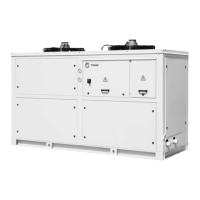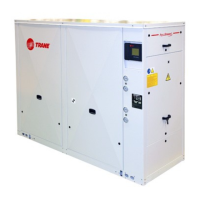RT-SVX060D-GB
42
4 UNT-PRC002-GB
Technical Data
FWD 08 12 20 30 45
Power supply (V/Ph/Hz) 230/1/50
Capacities
Cooling capacity on water (1) (kW) 5,2 8,3 15 18,8 30,1
Heating capacity on water (2) (kW) 6,3 11,9 18,9 20,9 38,2
Fan motor (type) 2 x direct drive centrifugal
Fan power input (3) (kW) 0,23 0,46 0,65 1,04 1,51
Current amps (3) (A) 1,1 2,2 3,1 4,7 5,5
Start-up amps (A) 3,2 5,5 9,3 14,1 16,5
Air flow
minimum (m
3
/h) 490 980 1400 1800 2700
nominal (m
3
/h) 820 1650 2300 3000 4500
maximum (m
3
/h) 980 1970 2600 3600 5400
Main coil
Water entering/leaving connections (type) ISO R7 rotating female
(Dia) 3/4" 3/4" 1 1/2" 1 1/2" 1 1/2"
Electric heater (accessory for blower only)
Electric power supply (V/Ph/Hz) 230/1/50 230/1/50 or 400/3/50 400/3/50 400/3/50 400/3/50
Heating capacity (kW) 2/4 8 10 12 12
Hot water coil (accessory for blower only)
Heating capacity (4) (kW) 6,3 12 17,4 22,4 34,5
G2 filter (filter box accessory)
Quantity 2 2 2 2 2
Dimensions ( LxWxth) (mm) 386x221x8 486x271x8 586x321x8 586*421*8 586*621*8
G4 filter (filter box accessory)
Quantity - 2 2 2 2
Dimensions ( LxWxth) (mm) - 486x264x48 586x314x48 586*414*48 586*614*48
Condensate pump (accessory) (type) Centrifugal
Water flow - lift height (l/h - mm) 24 - 500
Not available for FWD30 and FWD45
Sound level (L/M/H speed)
Sound pressure level (5) (dB(A)) 36/40/43 38/41/44 46/50/53 47/52/57 47/52/58
Sound power level (5) (dB(A)) 46/50/53 48/51/54 56/60/63 57/62/67 57/62/68
Unit dimensions
Width x Depth (mm) 890 x 600 1090 x 710 1290 x 820 1290 x 970 1290 x 1090
Height (mm) 250 300 350 450 650
Shipped unit dimensions
Width x Depth (mm) 933 x 644 1133 x 754 1333 x 864 1333 x 1008 1333*1133
Height (mm) 260 310 360 460 660
Weight (kg) 32 46 61 76 118
Colour galvanised steel
Recommended fuse size
Unit alone (aM/gI) (A) 8/16 8/16 8/16 8/25 8/25
Unit with electric heater (gI) (A) 16 (2kW),25 (4kW) 40 (230V),3*16 (400V) 3*20 3*25 3*25
(1) Conditions: Water entering/leaving temperature: 7/12 °C, Air inlet temperature 27/19°C DB/WB - Nominal air flow
(2) Conditions: Water entering/leaving temperature: 50/45 °C, Air inlet temperature 20°C DB - Nominal air flow
(3) At high speed with nominal air flow.
(4) Water entering/leaving temperature 90/70 °C, air inlet temperature 20 °C DB, Nominal air flow.
(5) A rectangular glass wool duct 1m50 long is placed on the blower.The measurement is taken in the room containing the blower unit.
Heat exchanger operating limits:
FWD:
*water temperature: max 100° C
*absolute service pressure: min 1 bar/max 11 bars
Accessories - Hot water coil:
*water temperature: min. +2° C/max. 100° C
*absolute service pressure: min 1 bar/max 11 bars
Controls
Zone temperature source
The zone temperature source are summarized in the
table below by hierarchy order.
Source Condition
1. BAS
BAS command enabled
&
Value in validity range [-10°C; +50°C]
2. Zone Temp Sensor
Ad-hoc Cong enabled
&
Value in validity range [-10°C; +50°C]
3. Zone Temp THS04
THS04 installed
&
Ad-hoc Cong enabled
&
Value in validity range [-10°C; +50°C]
4. Conventional Thermostat Ad-hoc cong enabled
4. Return Air Temp Value in validity range [-10°C; +50°C]
CO
2
sensor
CO
2
sensor can be either in air return duct or wall
mounted. It maintains a CO
2
concentration below a
preset value to ensure acceptable comfort.
Controls the opening of the fresh air damper of the
economizer. The outside air damper will modulate in
order to maintain the CO
2
concentration below the
setpoint.
To open damper it should combine the amount of
desired fresh air and the free cooling mode to modulate
from 0 to 100% maximum opening of the dampers.
It is possible to preset a minimum opening during
commissioning.
The CO
2
sensor is set for 0-10V analog outputs and
provide sensing of carbon dioxide over a range of
0-2000 ppm. The sensor requires a 24 VDC power
supply. Consult wiring diagram supplied with the unit
for details.
The resolution of analog outputs reaches 10 ppm CO
2
.
The information is then sent to the controller CH536 to
control the opening position of the fresh air damper.
Avoid locating the duct sensor on surfaces with an
uncooled, unheated area behind them or in “dead”
spot behind doors or in corners. The CO
2
wall mounted
sensor should be placed on a at surface, 1.4 m from
the oor in an area of the room where there is free air
circulation.
CO
2
sensor maintenance
This CO
2
sensor has excellent stability and requires no
maintenance. In most environments the recommended
calibration interval is ve years. A trained service
technician can use a portable CO
2
meter to certify
sensor calibration. If, when checking the sensor, the
reading differs too much from the reference value, the
sensor can be recalibrated in the eld. A calibration kit,
software, and calibration gases are required. If certied
accuracy is required, the sensor must be calibrated
against accurate and traceable calibration gases in a
laboratory. Consult Trane BAS for further details.
Fire thermostat
U12 is the dedicated I/O. Optional re thermostat should
be congured if present according to wiring diagram.
Clogged lter detector
This device is mounted in the lter section. The sensor
measures the difference in pressure before and after
the lter section. The information is sent to the optional
service terminal or the BMS.
Smoke Detector
Installation: This device is used to detect smoke in the
air stream. Detector is delivered by trane and must
be installed by the customer to comply with local
regulation. The detector must be connected to the
central panel according the wiring diagram.
Operation: When smoke is detected, it shuts off the unit,
and an alarm is activated in the controller to inform the
user through the local or remote control.
Other accessories available
- DTS : duct mounted wired temperature sensor
The duct mounted sensor - mainly for unit with auxiliary
heat - must be installed away of any duct singularities
and generally at 2 m of any duct elbow or duct inside
element both upstream and downstream.
- TZS01 : wall mounted wired temperature sensor
- THP05 : wall mounted thermostat
Refer to separate documentation for more information.
Alarm and Warnings
Alarms stop the unit or reduce the heating/cooling
capacity. Alarm can be either manual reset (requires
human intervention to re-start the unit) or automatic
reset.
Warning run the unit in fall-back mode.
Example : if outdoor air humidity sensor is not working,
the economizer runs in dry-bulb mode.
Events are accessible through optional local service
terminal which display the current events and
display history of past events (up to 99 alarms
and 99 warnings).

